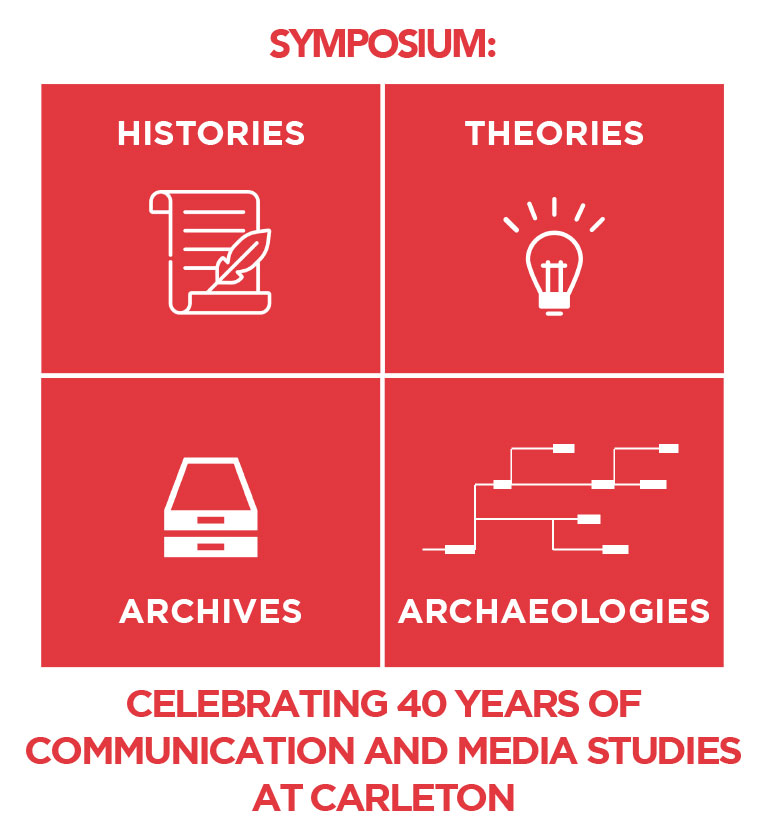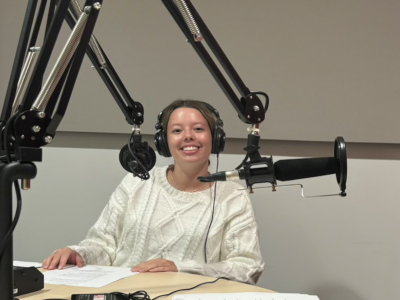Symposium Program – Friday, September 14, 2018
Welcome/Refreshments – 8:15 am
Opening Remarks – 8:30 am – 8:45 am
André Plourde, Dean, Faculty of Public Affairs
Josh Greenberg, Director, School of Journalism and Communication
Reflections: 40 years of communication studies at Carleton – 8:45 am – 9:45 am
Facilitator: Sheryl Hamilton (Carleton)
Participants: Karim Karim, Ross Eaman, Michael Dorland, Eileen Saunders, Carole Craswell
Histories – 9:45 am
Panel Session
Chair and Respondent: Miranda Brady (Carleton University)
Presenters:
Samantha Burton (Mozilla)
3 times technology panicked a generation: lessons for a healthier internet, from a history of technophobia
Asking your AI assistant for the weather, giving your data to tech giants in exchange for ‘free’ services, and seeing toddlers swipe through YouTube may be new phenomena, but the headlines about these technologies — often laced with fear and a sense of disempowerment — are not. This talk will look back at a history of moral panic about tech we take for granted today (like the telephone and TV) to offer insight into which of our current fears are hyperbole and which are well-founded, and ultimately to suggest how we might build a future where a healthy internet puts people first.
Laura Tribe (OpenMedia)
Digital advocacy for the future of the Internet
For the past decade, OpenMedia has been amplifying the voices of people who are concerned about the future of the Internet to ensure decision-makers are held accountable to the public’s needs, wants and concerns. But the landscape of advocating for an open, affordable, surveillance-free Internet has shifted in Canada and around the world, as governments change hands, corporations amass power and concentration, and digital tools become increasingly accessible to all sides of the debate. In the recent net neutrality fight in the U.S., the FCC falsely dismissed an overwhelming amount of citizen comments as a DDOS attack — potentially just to avoid recognizing the groundswell of opposition they were facing. Because of this, mass mobilization is increasingly being discredited, and citizens’ voices are being dismissed by those who find them inconvenient. How can we learn from the past and use the power of concerned voices to ensure that democracy is restored — not destroyed?
Emily Hiltz (Carleton)
Notoriety as Postfeminist Sensibility
Drawing on research findings from an image analysis of contemporary notorious criminalized women, this paper considers the analytic of notoriety in light of ongoing feminist critiques of post-feminism. I argue these subjects embody their historical and cultural contexts. The discourses animating their images support contradictory postfeminist sensibilities of knowingness that work to encourage further speculation on the meaning of femininity, sexual agency, and image management in contexts of hyper visibility and self-discipline. This paper seeks to extend critiques of postfeminist media by considering the role images play in producing notorious figures that provoke recursive judgements and anxieties.
Break – 11:15 am – 11:30 am
Theories – 11:30 am – 1:00 pm
Panel Session
Chair and Respondent: Chris Russill
Presenters:
Nora Draper (University of New Hampshire)
Unsettling the Communication Canon: Theorizing as Political Practice
What is a canonic text? This talk will engage questions of essential theory in the field of Communication Studies including what make a text canonic, the value of a disciplinary canon, and the need to rethink the parameters of “essential” texts. Referencing both research and teaching, the talk will point to the politics of theory and consider what it means to celebrate the history of a discipline.
Faiza Hirji (McMaster University)
Theory Has Its Uses—and Limits: Making Theory Work for Marginalized Populations
Advances in feminist, post-colonialist and critical race theories in the past few years have all helped scholars better understand the complexity of multiple oppressions for women of colour and religious minorities. However, while theory is a useful tool, academics that work with marginalized populations frequently discover theory’s limits. In the area of communication and culture, with particular emphasis on religious and visible minorities, we often come across some of following challenges: 1) conveying the significance of theory, which is complex, nuanced, and takes a long view, to populations that may be concerned with more basic and immediate needs; 2) understanding why audiences may ignore messages directed at improving their circumstances and instead favour messages and messengers that work directly against their interests; 3) understanding why audiences may endorse forms of media and popular culture that can be seen as biased or prejudiced against them; and 4) finally, addressing the ways in which theory can often address specific forms of oppression and even intersectionality, but cannot always provide all the answers for individuals or groups who may be experiencing multiple challenges and opportunities as they confront their own identities, as in the case of media producers who are visible minorities or groups whose members may be empowered in some instances and disempowered in others, and so on. In this discussion, we explore some of these challenges, and ask how we might address them in ways that allow us to use theory to its full potential.
Bethany Berard (Carleton)
Photography Theory: A Problem of Excess and Abundance
In the edited anthology 50 Key Writers on Photography, Joanna Lowry notes that “Writers have struggled with the problem of whether they are dealing primarily with a technology, a set of social practices, or an artistic medium, and the theoretical problems posed by this perennial ambivalence haunt every attempt to tell photography’s story or to establish coherent parameters for a theory of critical judgment or evaluation” (2013, p. 21). How are we to theorize photography, when “it,” whatever that may be, evades definition? This paper provides a brief historical outline of how photography has been theorized and argues that the problems of abundance or excess that theorists of photography contend with can perhaps be considered as a theoretical solution rather than problem. Historically attempts to theorize photography have faced two key problems: the problem of the ontological flexibility and shifting nature of photographs, and the problem of the multitude of tools and techniques that make up the practice of photography, and with the advent of digital image capture these two problems have become increasingly pronounced. I suggest that approaching photography through communication and media studies can position these problems.
Lunch – 1:00 pm – 2:00 pm
Archives – 2:00 pm – 3:15 pm
Panel Session
Chair and Respondent: Dwayne Winseck (Carleton University)
Presenters
Irina D. Mihalache (University of Toronto)
Recipes in Competition: Chatelaine, Canadian Home Cooks and Un-Making Cuisines
This talk uses recipes from the popular recipe competition “Fifty Favourite Recipes” (Chatelaine, 1951-1968) to demonstrate how negotiation is central to the formation of cuisines. The recipe competition – a form of culinary sharing – comprises recipes sent in by women (and some men) from all parts of Canada, which can be mapped out, geographically, to show a culinary culture in constant movement. Recipes such as Chop Suey, Dry Curry Powder and Real Italian Spaghetti are mobile as they incorporate “foreign” ingredients, which, through the process of circulation become (or are naturalized) as Canadian.
Jonathan Shaughnessy (National Gallery of Canada)
From archive to form: Contemporary art and the historical document
In recent decades the archive has become an increasingly prominent resource within contemporary art and exhibition-making. This interest speaks to a broader imperative of making visible that has been marginalized, or rendered subordinate to dominant historical narratives. Drawing from the NGC’s upcoming exhibition Vision Exchange: Perspectives from India to Canada, this presentation will examine some of the ways in which archival documents – ranging from the personal to the art historical, as well as the geopolitical – are transformed by artists using various media including film, photography, sculpture, and works on paper.
Nadia Hai (Carleton)
Magazines as Movement Archives: Comparing the Narrative themes of Daesh’s Dabiq and Rumiyah, and al Qaeda’s Inspire magazine
This paper presents an analysis of Daesh’s Dabiq and Rumiyah magazines and al Qaeda’s Inspire magazine, with a focus on issues published between 2011-2017. Dabiq, Rumiyah and Inspire magazines are all published and distributed online in English. These publications represent part of a larger archive of al Qaeda and Daesh’s larger media operations creating and distributing content in multiple formats, languages, and across several platforms promoting wider global movement that appeals to those with little to no ties (e.g. ethnic, linguistic, kinship) to the land they are fighting in (e.g. Iraq, Somalia, Libya, Afghanistan). This archival data can shed light on the frames al Qaeda and Daesh use to appeal to their diverse audiences in Western societies and how these narratives shift over time. Analysing materials produced and distributed by al Qaeda and Daesh’s official media organizations like Dabiq and Inspire, provide important insights into what ideas or other movement texts the “official” or centre of the movement wants to present to their English-speaking audiences.
Break – 3:15 pm – 3:30 pm
Archaeologies – 3:30 pm – 5:00 pm
Keynote Lecture
Introduction: Liam Cole Young
Shannon Mattern, Professor, The New School
Amending Care: An Archaeology of Maintenance
The past year has revealed countless breaches of responsibility: hacked accounts, unguarded data, fake news, Russian trolls, leaked recordings, broken global alliances, rigged elections, severed migrant families, sexually harassed women, and wilful deception at the highest levels of government. The list goes on. Such egregious and boundless negligence has incited detached discussions about revolt, remediation, and repair. In many academic disciplines and professional fields, repair has taken on new resonance as an ethos, a methodology, and a political cause. As Andrew Russell and Lee Vinsel, leaders of The Maintainers movement, acknowledge, a shift in focus from innovation to repair and maintenance forces us to acknowledge the historical, political, social, cultural, and ecological contexts of technology and, more broadly, techne. We might say that studies of maintenance promote an archaeological framework. Yet I propose that that, in order to better understand and apply maintenance as a corrective framework, we need an archaeology of maintenance itself — one that more fully engages with parallel discourses of care; and that acknowledges the legacies of women’s work, reproductive labour, information work, and practices of preservation and conservation in various fields.
Respondent: John Shiga (Ryerson University)
Off-site drink and snacks (Location TBD) – 5:45 pm
Friday, September 14, 2018 in Special Events
Share: Twitter, Facebook




